Ne Zha 2 – When Myth, Magic, and Personal Struggle Collide
Introduction
In 2025, Ne Zha 2 arrived in cinemas as more than just a sequel. It showed that Chinese animation has matured in its ambition, technical skill, emotional depth, and box office power. Built on ancient myth but told with modern eyes, the film takes familiar folklore and elevates it to speak to identity, destiny, injustice, and the meaning of heroism.
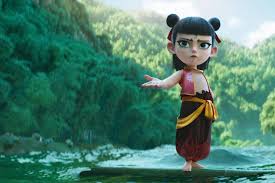
While the first Ne Zha (2019) already made waves for its bold reimagining of a mythological character, Ne Zha 2 pushes further—combining spectacular animation, rich world-building, moral complexity, and emotional stakes, all woven into a story that is both entertaining and meaningful.
What the Story Sets Up
Ne Zha 2 follows directly from its predecessor. The world is one where myth, spirits, gods, demons, immortals, magic artifacts, and the supernatural are real, and human lives intersect deeply with those ancient forces. The central characters are Ne Zha himself and Ao Bing. In the earlier film, their destinies were intertwined via a powerful artifact called the Chaos Pearl, which split into parts, transforming Ne Zha and Ao Bing into powerful beings of opposing natures.
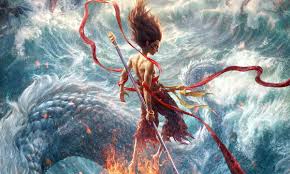
A key plot drive is to restore their mortal bodies. They must undergo tasks, trials, or seek magical means (for example, items like a sacred lotus or other enchanted objects) to reconstruct or resurrect what was lost.
There are opposing factions: immortal ones, dragon royalty, demon or spirit folk, and other supernatural beings. Some are benevolent, some corrupted, some seeking power. The stakes grow as betrayal, injustice, oppression, and hidden agendas come to light.
The journey takes the heroes through multiple fantastical realms—palaces of immortals, watery seas, underworld regions, places of elemental danger, and vivid, imaginative settings where magical rules apply.
While action, magic, and spectacle are abundant, so are the emotional threads: friendship (especially between Ne Zha and Ao Bing), parental and familial love, sacrifice, guilt, remorse, what it means to be responsible for more than oneself, and what identity means when you are part divine, part spirit, and part human.

The film also explores themes of injustice: how the powerful treat the powerless (for example, demons or spirits under oppression), how prejudice shapes actions, and how destiny sometimes seems to demand conformity, but individuals push back.
Main Characters & Their Arcs
These are some of the key players in Ne Zha 2, and why they matter:
Ne Zha: A complex hero. He has immense power, but also a lot of recklessness, youthful impulsivity, and often a struggle with identity—what he truly is, what expectations are placed on him, and what destiny demands of him. He wants to help, to restore, to protect, but often must learn to balance power with responsibility.
Ao Bing: Ne Zha’s friend and counterpart. Because of their shared history (via the artifact splitting etc.), Ao Bing carries an emotional and spiritual weight. His journey is about reconciliation—with his family, with what he believes, with his role—especially when forces outside him try to use his legacy or nature for their own ends.
Lady Yin and Li Jing (Ne Zha’s parents): Provide the familial anchor. Their relationship with Ne Zha shows the tension between parental love and letting children grow into their own. They also represent tradition, human frailty, compassion, and sometimes fear of what lies beyond ordinary human understanding.
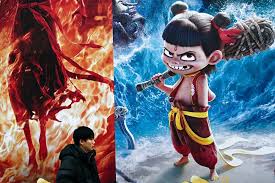
Master Taiyi Zhenren and other Immortals: They act as mentors, custodians of magical lore and mystical duty. They carry wisdom but also the burden of judgment. The immortal realm has its own politics, hierarchies, and moral ambiguities.
Dragon royalty / Sea Kings: Represent power tied to nature, tradition, generational leadership, sometimes antagonism toward humans or other realms, but also a sense of honor, responsibility, and deep emotional stakes (especially in Ao Bing’s case).
Antagonists & Forces of Corruption: These may include rogue immortals, demons or spirits being mistreated, or powerful beings who manipulate law, power, or magic to exploit others. They force the heroes to question not just how to fight, but what side of justice they’re on.
Themes & Messages
Here are the big ideas Ne Zha 2 works with. These make it more than a spectacle—it’s a story with heart, philosophy, and cultural weight.
Destiny vs Free Will
One of the biggest questions is whether characters are bound by the roles myth assigns them (heroes, spirits, gods, dragons), or whether they can choose differently. Ne Zha, Ao Bing, and others wrestle with expectations placed upon them: by artifact, by tradition, by lineage. The film asks: can you escape what you were “born” to be, or must you embrace it, even if parts of it are painful?Identity & Dual Nature
When you are part spirit, part artifact, part divine, part human—who are you truly? There are internal conflicts about self-image, about how others see you (demons, humans, gods), and what parts of yourself you have to suppress or celebrate.Power, Corruption, & Injustice
The story doesn’t shy from showing how power can corrupt—or at least how the misuse of power or the cruelty of “justice” can have devastating consequences. Some antagonists believe strongly in order or tradition, but their actions betray mercy. Demons or spirit folk often suffer under prejudice or exploitation.
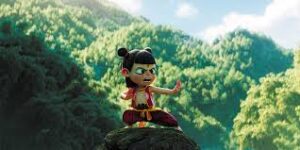
Sacrifice & Family
Many characters have to make sacrifices: of safety, personal desires, relationships. The love of parents, loyalty of friends, obligations to different realms—they all pull at the characters. Some sacrifice willingly; others are pushed by circumstances.Cultural & Mythological Roots
The film draws heavily from Chinese mythology (especially Investiture of the Gods / Fengshen Yanyi), traditional folklore, legendary figures, cosmic balance, immortality, dragons, demon-spirits, magical relics, etc. But it also adapts those myths for modern sensibilities: the idea of justice, personal agency, empathy across difference, resisting injustice rather than simply obeying divine law.Hope, Change, and Rebellion
Because many characters are dissatisfied with how things are—how certain beings are oppressed, or how power is abused—there is a strong spirit of rebellion, reform, even revolution. Not necessarily in a violent sense only but in moral sense: challenging what is assumed, reforming systems, choosing compassion over cruelty.Friendship & Loyalty
The bond between Ne Zha and Ao Bing is central. It’s not just about being comrades in battle but about shared burdens, broken bodies, wounded spirits, and the emotional cost of what they’ve both suffered. Lives are more than mythic powers—they include memories, guilt, fear.
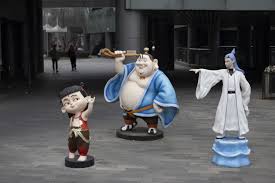
Visuals, Sound, & World-Building
One of the most talked-about elements of Ne Zha 2 is how breathtaking it looks and sounds. The animation is often stunning, mixing sweeping fantasy landscapes with detailed character work. Below are what stand out:
Animation Quality & Style: The film uses state-of-the-art CGI with tremendous attention to detail. The mythical creatures, dragons, demons, spirits, supernatural forces—all are rendered with complexity, texture, fluid motion. Scenes of water, fire, elemental magic, celestial lightning, palace interiors, underwater realms, and otherworldly domains are rich in color and design.
Action & Choreography: Battles are dynamic. Not just big, loud, flashy fights, but many moments where smaller physical movements, magic, timing, and environment matter. The choreography of fight sequences often plays with scale, tempo, danger, landscape, supernatural abilities. There’s a balance between epic scale (dragon armies, cosmic threats) and personal combat or emotional confrontation.
Design of Mythical Realms: The film builds multiple realms—celestial palaces, undersea kingdoms, spirit worlds, human villages, mountain passes, etc. Each setting feels visually distinct and immersive. Light, color, sound, architecture, creature design all change to reflect mood, theme, and the nature of that world.
Soundtrack & Music: Music helps carry the emotional weight. There are sweeping orchestral pieces, traditional instruments, folk motifs, and cultural musical styles that infuse authenticity. In high tension or battle moments, sound effects, voice work, ambient sound all contribute to immersion. Quiet moments are given space, letting the audience feel the loss, the anticipation, the emotional cost.
Humor, Tone, Balance: While much of the film is action, fantasy, moral seriousness, there are comedic moments—slapstick, character banter, and lighter side plots. These moments help offset tension and make characters more human. The balance helps the film avoid becoming overly grim; it gives breathing room between intense sequences.
Strengths: What Ne Zha 2 Does Very Well
Here are the film’s major strengths—why so many audiences and critics have responded so positively.
Emotional Resonance
Despite the mythical and supernatural scale, the film keeps its focus on characters: their fears, relationships, guilt, hopes. When characters suffer, audience feels it. When they hope, the hope is earned.Ambitious World-Building
The film doesn’t settle with one type of realm or style. It moves among underwater kingdoms, demon lands, immortal palaces, human settlements—all these realms feel lived-in, textured, varied. This variety keeps the journey visually stimulating.High Stakes + Personal Stakes
The dual nature of risk makes the conflict compelling. It’s not just whether the world will survive, but whether Ne Zha will reclaim his body, whether Ao Bing will be restored, whether hearts and families will heal. It raises the stakes beyond the usual.Cultural Identity & Myth Bending
Pulling from classical Chinese mythology gives it deep roots, but the story reinterprets and sometimes subverts myth in interesting ways—addressing injustice, hierarchy, prejudice, conformity. It feels rooted yet fresh.Spectacular Visuals & Sound
The technical achievements are very high. Animations of dragons, elemental magic, battle sequences, fantastical creatures, environmental effects, lighting, color palettes—all are often breathtaking. The music and sound design compliment rather than distract.Themes That Feel Universally Relatable
Even if one doesn’t know all details of Chinese myth, the themes of what one owes to family, what one wants to be, resisting injustice, friendship, identity—these are globally relatable.Strong Sequel That Grows the Universe
The film doesn’t just retell the same beats; it expands the mythos, adds complexity, introduces new conflicts, and raises questions that weren’t addressed in the first. It’s a sequel that both entertains and deepens.
Potential Weaknesses & What Some Viewers Might Dislike
No film is perfect, and Ne Zha 2 is no exception. Depending on tastes, some aspects may feel overwhelming or less satisfying.
Complexity & Narrative Density
The film juggles many characters, realms, subplots, conflicts. Some viewers may find parts of the story heavy or hard to follow, especially if they are not familiar with myth or cultural background. Some sequences (trials, battles, political intrigue) can feel dense.Pacing Variability
Some parts of the second act slow down; scenes meant to build world or character sometimes delay the momentum of the action. The buildup is generally strong, but some sections may feel drag-heavy for those expecting constant action.Overuse of Action Spectacle
While animation and action design are impressive, at times the film leans heavily into large-scale fight scenes, which may feel repetitive or overly loud. Some battles or visual sequences are ambitious but may blur together if too many similar types of scenes occur.Tone Shifts
The film mixes grand mythic seriousness with comedic relief, slapstick, and lighter moments. For some, the shift between intense drama or tragic sacrifice and humor (sometimes crude) may feel jarring or inconsistent.Cultural Specificity as Barrier
The film’s mythological roots are rich, but some of the references, historical context, or mythic lore may be hard to fully appreciate without cultural background. Subtitles or dubbing may lose nuances. Cultural symbols, thematic layers may be less immediately resonant for international viewers not familiar with the myths.Villain Complexity vs Screen Time
Some antagonists are richly drawn; others less so. A few villains or side characters feel more like plot devices than fully fleshed individuals. Their motivations may sometimes appear simplified in service of larger story arcs.
Reception & Box-Office Performance
One of the most remarkable things about Ne Zha 2 is how it has performed—both financially and in audience/critical response.
It has broken numerous box office records in China. When it was released around the Chinese New Year period, it quickly rose to become one of the highest-earning films in Chinese cinema.
In doing so, it overtook prior animated blockbusters both domestically and internationally. The financial success is not just about raw numbers: it signals the capacity of Chinese animation to compete globally not just in scale but in its emotional and mythic depth.
Critical response has been largely positive. Reviewers often praise the film’s ambitious storytelling, visuals, emotional core, mythic themes, and how it raises questions beyond simple good vs evil.
Some criticism revolves around pacing and narrative density, as noted above, but overall, the consensus is that Ne Zha 2 is a step forward in what animated fantasy can do, particularly coming from a non-Hollywood tradition.
Cultural, Mythological, & Global Significance
Beyond being a large success, Ne Zha 2 has significance in several deeper ways.
Revival & Reinforcement of Myth: It brings Chinese myth to center stage in ways that are both respectful and creative. Rather than treating folklore as static, it reinterprets, reexamines, and uses myth to pose questions relevant to contemporary life—identity, justice, power, and rebellion.
National Pride & Cultural Soft Power: The film has become part of discussions about China’s animation industry’s rise. It shows that domestic productions can compete with international animation in terms of scope, technical quality, box office performance, and emotional storytelling.
Universal Themes Bridged Through Specificity: Because the mythological references are specific, but the human dilemmas are universal, the film bridges cultural specific storytelling and global relatability. That’s a strong model for future animated films globally.
Technical Benchmark for Animation: The animation industry sees Ne Zha 2 as an example of what can be achieved with high budgets, strong talent, ambitious world design, and leveraging both mythic tradition and modern animation techniques.
Discussion on Power, Injustice, Prejudice: The film raises issues of how the “other” is treated (demons, spirit folk), how leadership and institutions can abuse power, and how individuals within those institutions can either perpetuate or challenge that abuse. These ideas resonate beyond myth: in real societies, in politics, in identity.
Why Ne Zha 2 Matters for Animation & Storytelling
Ne Zha 2 isn’t just a success story in terms of revenue. It matters because it pushes the boundaries of what myth-based animation can be, both in China and globally.
It shows that myth and fantasy aren’t just escapism; when done with care, they can reflect pressing moral questions, emotional complexity, social justice, identity, belonging.
It sets a higher bar for production values in global animation—not simply spectacle, but design, sound, music, pacing, and emotional resonance all working together.
It helps open a door for non-English language animated films to gain wider global recognition—not just niche or art-circuit, but blockbusters that are being talked about worldwide.
It demonstrates that cultural specificity (myth, folklore, art style) can be a strength rather than a barrier if treated with authenticity and narrative clarity.
Who Will Love Ne Zha 2 & Who Should Be Prepared
If you’ll likely enjoy this film:
Fans of animation, fantasy, and mythological stories that aren’t afraid to get big in visuals and emotion.
Viewers who appreciate depth as well as spectacle—those who want both action and meaningful character arcs.
People interested in cultural myth, folklore, stories from outside the Western canon.
Audiences who don’t mind some scale, complexity, and perhaps slower patches in storytelling.
If it might be challenging for you:
If you prefer very lean plots with minimal subplots, or you dislike stories with many characters and dense mythic lore, some parts might feel heavy.
If you are sensitive to loud, intense battle scenes, or quick shifts from humor to drama.
If your familiarity with Chinese myth is limited, some references or mythological background might feel confusing or lose some nuance.
If you prefer only modest stakes or small, grounded stories—not epic warfare, gods, dragons, spirits, etc.
Comparisons, Inspirations, & Place in Global Animation
It’s helpful to see Ne Zha 2 in relation to other films and traditions:
It echoes the mythic/fantasy tradition found in animation globally—think some aspects of Spirited Away, Avatar: The Last Airbender, How to Train Your Dragon—films that mix magical realism, culture, activism or moral messages, and big action. But Ne Zha 2 has its own cultural flavor, its own mythological heritage.
It also stands as part of China’s growing animation industry push: higher budgets, wider ambition, willingness to tell culturally rooted stories that appeal both at home and abroad.
The film adds to the trend of animation not just for kids: more complex moral conflicts, deeper emotional pains, broader thematic ambition.
Final Thoughts
Ne Zha 2 is an impressive piece of animated fantasy adventure. It takes the raw material of ancient myth and gives it contemporary resonance: fighting for identity, confronting injustice, choosing courage in the face of overwhelming odds, honoring love, and acknowledging grief.
It’s a film of grand vistas and intimate moments. It asks its audience not just to watch dragons and magic, but to feel what it is to be torn between roles, to carry loss, to hope that we are more than what fate or others say we are. Its technical brilliance—animation, sound, world design—provide the canvas, but it’s the characters’ hearts that truly carry the story.
For those exploring mythology, cultural storytelling, global animation, Ne Zha 2 marks a landmark. It’s an example of how myth can be vibrant again, how animation can carry weight, and how stories deeply rooted in one tradition can still carry universal meaning.
FAQs
Q1. Do I need to watch Ne Zha (2019) before seeing Ne Zha 2?
No. While watching the first film helps understand some backstory, Ne Zha 2 provides enough context to follow the characters, motivations, and stakes on its own.
Q2. Is Ne Zha 2 suitable for children?
It is animated, but the film has intense action, supernatural violence, large-scale battles, and emotional themes (loss, sacrifice). Younger or very sensitive viewers might find some scenes scary or overwhelming.
Q3. How long is Ne Zha 2, and in what formats is it available?
The film is about two hours and twenty-plus minutes. It has been released in various theaters including premium formats (like large screens or IMAX equivalents) in some markets, depending on local distribution.
Q4. What is the animation style like?
High quality CGI with rich detail. Fantastical creature designs, fluid movements, vivid settings across multiple realms. Both large scale battles and intimate emotional scenes are well handled.
Q5. What are some of the culturally specific elements in the film? Will they make sense to non-Chinese audiences?
Yes and no. The film uses many elements from Chinese myth and folklore—dragons, demons or spirits, immortals, magical potions, moral expectations from tradition. These are presented in ways that are often intuitive (good vs evil, friendship, destiny), but some details or symbols may be more meaningful if one knows myth or cultural context. Subtitles or dubs may lose nuance, but the central themes are accessible.
Q6. What makes Ne Zha 2 different from other fantasy or myth-based animations?
Its combination of myth rooted in ancient text with modern storytelling, its emphasis on moral ambiguity and injustice, its technical polish, its emotional core around friendship and parental love, and its willingness to ask hard questions about identity and power distinguish it.
